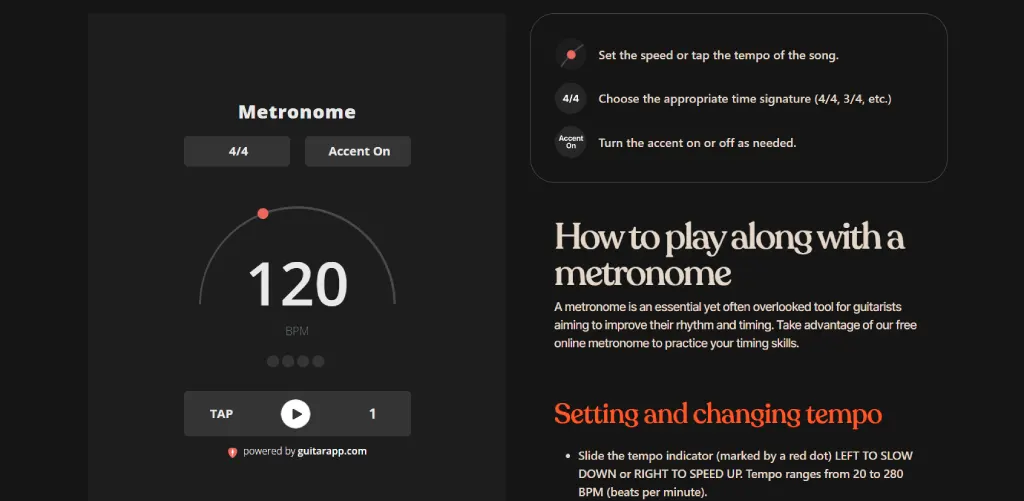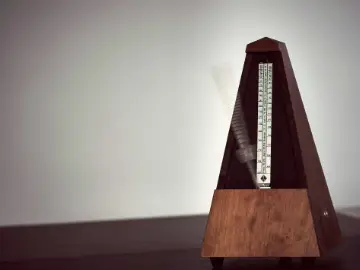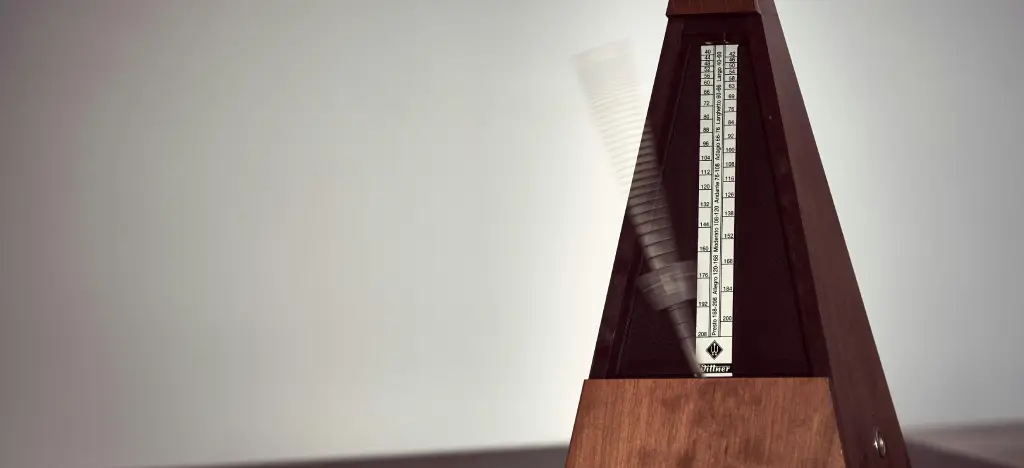For some musicians, it's a loyal practice companion; for others, an unforgiving taskmaster. But love it or hate it, playing with a metronome is one of the best tools for improving your timing, rhythm, and overall technique. And it’s highly recommended by teachers for piano, guitar, and almost every instrument.
In this guide, you’ll discover how this simple device can transform your practice sessions, with expert tips, a free online metronome, and a guitar video playthrough. Whether you’re aiming for studio-perfect precision or just want to tighten your groove, a metronome is the secret weapon you didn’t know you needed.
- What is a metronome and how does it work?
- Types of metronome
- Free online metronome
- Why should you practice with a metronome?
- Video: Guitar playthrough to metronome
- How do you stay in time with a metronome?
- Tips on practicing with a metronome for guitar & piano
- Common problems when playing with a metronome
- Discover more ways to play
What is a metronome and how does it work?
A metronome is a tool that helps musicians develop precise timing and rhythm by producing a steady click, beep, or pulse at a chosen speed — measured in beats per minute (BPM). It’s one of the most effective ways to improve your playing, whether you’re on guitar, piano, or any other instrument.
When you set a metronome to a specific BPM, it creates a consistent tempo that guides your practice. This not only helps you play evenly but also trains your internal sense of timing — essential for both solo performances and playing with others.
Common BPMs:
60 BPM – One beat per second (great for slow practice or ballads)
120 BPM – Standard pop tempo (used in pop, rock, and dance music)
200 BPM – Fast-paced rock or metal (typical in punk, thrash, or speed metal)
Whether you’re slowing things down to focus on tricky passages or speeding up to match studio tempos, a metronome is there to keep you locked in and on beat.
Types of metronome
 Not all metronomes are created equal — they come in different styles to suit various practice needs. Here are the main types:
Not all metronomes are created equal — they come in different styles to suit various practice needs. Here are the main types:
Traditional mechanical metronome
The classic pyramid-shaped metronome with a swinging pendulum and ticking sound.
No batteries needed — simply wind it up.
Adjustable tempo — move the weight on the pendulum to set the BPM.
Loved for its visual cue (watching the pendulum swing can help with timing).
It’s not just functional — it’s a design classic!
Digital metronomes
Modern, portable, and packed with features, digital metronomes come as standalone devices, mobile apps, or online on websites.
Precise BPM control
Time signatures (e.g., 4/4, 3/4, 6/8)
Tap tempo — tap along to match a song’s speed
Accents — highlight the first beat of each bar for complex rhythms
Free online metronome
 If you want a quick, no-fuss option, ArtMaster’s Free Online Metronome is available anytime, anywhere.
If you want a quick, no-fuss option, ArtMaster’s Free Online Metronome is available anytime, anywhere.
Set any BPM
Change time signatures
Tap to match your favourite song’s beat
No downloads required
► ARTMASTER TIP: If you’re a guitarist, a metronome isn’t the only essential tool you’ll need. Take a look at our collection of free customizable guitar tools, where you’ll also find a chord chart generator and a guitar tuner.
Why should you practice with a metronome?
A metronome isn’t just a tool for beginners — even pros use it to sharpen their skills.
1. Improve your sense of rhythm
Practicing with a metronome trains your brain to anticipate beats, improving your natural sense of timing.
2. Master speed gradually
Start slow, then build up. Metronomes help you focus on precision before pushing for speed — ideal for tricky solos or fast piano runs.
3. Maintain a steady tempo
It’s easy to speed up when you’re “in the zone.” A metronome forces you to stay steady, ensuring consistency in both practice and live performances.
4. Perfect for studio recording
Timing errors in the studio can cost time and money. Practicing with a metronome helps you nail recordings on the first take.
5. Track your progress
Increasing the tempo over time is a simple but satisfying way to measure improvement.
► ARTMASTER TIP: Once you’ve nailed your timing, try these 100+ easy four-chord songs to put your skills into practice.
Video: Guitar playthrough to metronome
Watch guitar virtuoso Kfir Ochaion practice Eric Clapton’s "Wonderful Tonight" using a metronome set at 70 BPM. See how he focuses on timing and precision before building up to full speed.
🎸 Want to take it further?
Join Kfir Ochaion’s Solo Course and learn from a guitarist followed by over 5 million fans. Perfect for intermediate players aiming to master lead guitar.
How do you stay in time with a metronome?
Staying in time with a metronome can feel tricky at first, but with the right approach, it becomes second nature. Here’s how to lock into the beat and sharpen your timing:
🎵 Go slow to start:
Begin at a slow tempo where you can play cleanly and accurately. Master the basics before increasing speed.👂 Listen carefully:
Focus on aligning your notes exactly with the metronome’s clicks. If you find yourself ahead or behind, pause and reset.⚡ Break it down:
For complex sections, imagine each click as subdivided into smaller beats (e.g., eighth notes or sixteenths) to improve precision.👣 Tap your foot:
Physically tapping your foot along with the beat helps internalize the rhythm and keeps your body in sync with the tempo.👀 Use visual cues:
If your metronome has flashing lights or a moving pendulum, use these visual signals alongside the clicks to stay in time.🚀 Increase speed gradually:
Once you’re comfortable at a slow tempo, increase the BPM in small increments to build speed while maintaining accuracy.🔁 Practice regularly:
Consistency is key. Frequent practice with a metronome will strengthen your timing and make it feel natural.🎯 Focus on tricky sections:
Loop challenging parts and slow them down. Gradually bring them up to tempo until they flow effortlessly.
Tips on practicing with a metronome for guitar & piano
No matter if you're playing your favourite guitar solos or improving your piano technique, a metronome is a great practice tool. Here's how to use it effectively for both instruments:
🎸 Guitar practice tips
Match your strumming or picking to the beat:
Whether you’re playing chords or lead lines, make sure your hands move in sync with each metronome click.Sync both hands for smoother playing:
Focus on the coordination between your picking/strumming hand and fretting hand. This builds speed and clarity over time.Use different time signatures:
Experiment with 3/4, 6/8, or 5/4 time signatures to develop rhythmic versatility.Practice scale runs and solos slowly first:
Run through scales, arpeggios, and solos at a reduced BPM, gradually increasing speed as accuracy improves.
Curious how long it’ll take to perfect your timing and technique? Here’s a realistic roadmap.
🎹 Piano practice tips
Practice hands separately, then together:
Start with one hand at a time to focus on timing. Once each hand is confident, combine them and play along with the metronome.Use subdivisions for complex passages:
Set the metronome to click on smaller beats (like eighth or sixteenth notes) when tackling fast or intricate sections.Maintain a steady pace across the keyboard:
Whether you’re working on arpeggios, scales, or full pieces, focus on even timing as you move between octaves.Play with dynamics while staying in time:
Challenge yourself to play louder or softer without losing the beat — a skill essential for expressive piano playing.
Want to speed up your piano progress? Check out our guide for busy adults for efficient practice tips.
► ARTMASTER TIP: For more music practice tips & techniques, check out our guide — The art of effective music practice.
Common problems when playing with a metronome
Practicing with a metronome can be frustrating at first — especially when it feels like the click is speeding up or slowing down. Here are some of the most common challenges musicians face and how to overcome them:
🎵 Problem | 💡 Why It Happens | ✅ How to Fix It |
|---|---|---|
“The metronome is speeding up!” | You’re unintentionally rushing the tempo. | Slow the BPM and focus on hitting each click precisely. |
“I fall behind on faster sections.” | Complex parts throw off your timing. | Break the section down, practice slowly, then build up speed. |
“The click is too hard to follow.” | The sound isn’t cutting through your playing. | Use headphones, a louder click sound, or visual cues. |
“I can’t play steadily for long periods.” | Mental fatigue causes timing slips over time. | Break practice into short, focused sessions with clear goals. |
“I lose the beat when playing tricky rhythms.” | Subdivisions or syncopated parts disrupt your timing. | Use subdivisions (eighths or sixteenths) and tap your foot. |
“The metronome throws me off rhythm.” | You’re listening to the beat rather than playing with it. | Focus on locking into the beat and internalizing the tempo. |
💡 Tips for overcoming metronome frustrations:
Start slower than you think you need to. Master the piece at a low BPM before increasing speed.
Use visual aids (like flashing lights or pendulums) if clicks alone aren’t helping.
Record your practice and listen back — sometimes mistakes are more obvious when you’re not actively playing.
Alternate between playing with and without the metronome to build your internal sense of timing.
► ARTMASTER TIP: Struggling with rhythm and timing? Strengthen your foundations with beginner music theory.
Discover more ways to play
Looking to tighten up your timing on guitar, piano, or even bass? Check out our courses on electric/acoustic guitar, piano, bass and more!
Try Our FREE 7-Day Trial!


